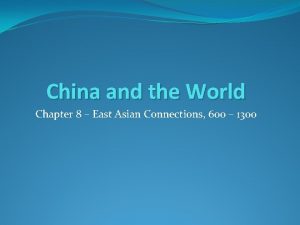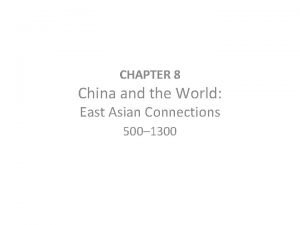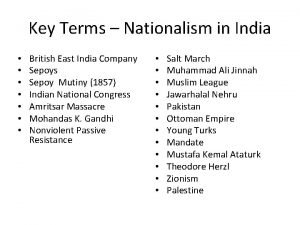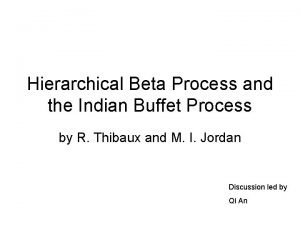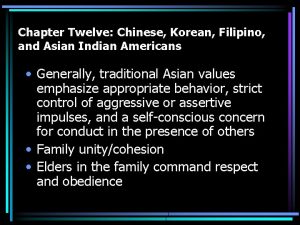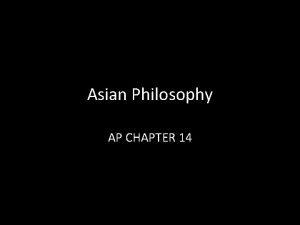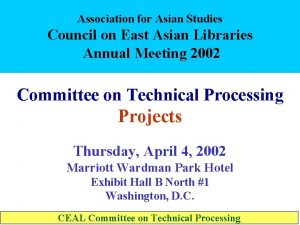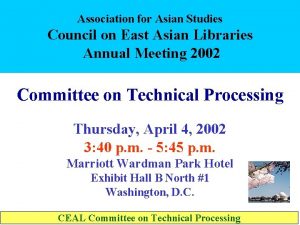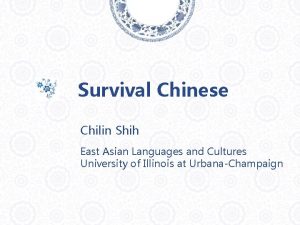HISTORICAL PROCESS ASIAN CHINESE AND EAST INDIAN MIGRATION













- Slides: 13

HISTORICAL PROCESS ASIAN: CHINESE AND EAST INDIAN MIGRATION

CHINESE MIGRATION • Https: //www. youtube. com/watch? v=q. PVEFaxrw 1 M • DR. WALTON LOOK LAI • 2007 CUNY CONFERENCE ON CARIBBEAN ASIANS • Retired Professor of History and Author. University of the West Indies-St. Augustine; Rutgers University-Newark City University of New York.

ASIAN MIGRATION CHINESE ARRIVAL • 1806. This was the first wave Chinese migration which was implemented by the British. It was believed that they would provide a cheaper source of labour than the Africans. In this journey approximate 200 Chinese immigrants arrived to work on the sugar plantations. These migrants, were given the opportunity to return to China. It was not a success since most decided to return to China and approximately 30 migrants stayed in Trinidad. • 1853 -1884. Approx. 18, 000 came to the Caribbean to work on the sugar estates as indentured labourers. These peasants were from Guangdong and Fujian provinces in South East China. This was the second wave of Chinese migrants. • Most went to Guyana, approximately 14, 000; Trinidad received approximately 3000; Jamaica received approximately 1000. Thus, Chinese indentureship was mainly an experiment that occurred in Guyana.

ASIAN MIGRATION • These Chinese indentured labourers were placed on about 70 plantations throughout Trinidad and on about 116 plantations in Guyana. • These Chinese Indentured labourers were offered a five year contract to work on the sugar plantations, a wage ($4 -$6 dollars a month), some were offered free food and some were offered a plot of land on the completion of their contract. • In the case of Chinese indentureship, families were encouraged to come together. So they were able to maintain a family unit which included women. • By 1880, many left the plantations to engage in small businesses. They became rural and urban shop keepers.

ASIAN MIGRATION • 1880 -1940’S. There was a jump in Chinese migration to the Caribbean. This coincided with the period of “Chinese Exclusion” which was happening in the U. S. The Chinese Exclusion Act, formally Immigration Act of 1882, was a law which suspended the migration of Chinese labourers from entering the U. S. • During this period, approximately 8000 Chinese came to the Caribbean as free migrants and engaged in small business activities. These migrants were from the Pearl River Delta in the Guangdong province. Most of the West Indian Chinese that we have today, are the descendants of this wave of migrants. • 1980’s. The willingness of China to open its borders to the rest of the world through globalisation allowed for the continued movement of Chinese migrants to the Caribbean. These movements were sporadic and informal. During this time, approximately 1000 migrants came to Trinidad.

ASIAN MIGRATION • EAST INDIAN ARRIVAL • REASONS FOR MIGRATION: https: //www. youtube. com/watch? v=wv 7 my. ABr 6 Ak • https: //www. youtube. com/watch? v=Et. ICIf. A 7 NRU • https: //www. youtube. com/watch? v=SBSHns 8 wr. Wc

ASIAN MIGRATION • Arrived on May 30 th, 1845 after a three month journey from India. • 84% were Hindus; 16% Muslims and the remaining came from tribal other religions. • They wanted to escape poverty, flooding, droughts, starvation, and caste system. Thus, they were willing to look for a better life elsewhere. • Some peasants in India became landless because of British policies. • Some were kidnapped and others came out of a sense of adventure. • Most labourers came of towns that were highly populated. • Some came from the towns of Faizabad, Lucknow and Patna • Some labourers had previously participated in revolt against British colonialism and were looking for a safety.

ASIAN MIGRATION • Some labourers committed suicide on the journey out of despair. • The conditions on the ships were harsh and unsanitary. The East Indians saw the crossing of the Paagal Sumundar, a narrow channel of the Indian Ocean, as the worst part of the journey. Many became ill, some died due to disease. • On arrival, they were taken to estates in Diamond Vale, St James, Caroni and along the East-West Corridor. • On the estates, they were placed in cramped Barracks much like those previously inhabited by the Africans. • The arrival of the East Indian labourers increased racial tensions as conflicts arose out of competition for wages, land other resources.

ASIAN MIGRATION • Diseases were rampant and little medical care was given. Thus, many died of diseases. • The freed slave were in the process of negotiating for higher wages when the East Indians arrived. Thus, they were seen as scab labour by the Africans because they blamed them for breaking the negotiations with the plantation owners. • They too, like the African, engaged in hard labour on the plantation. Children were also required to engage in plantation labour. The women were expected to perform labour on the plantation and in the home. They too, were vulnerable to sexual abuse by White and East Indian men.

ASIAN MIGRATION • East Indians also engaged in peasant farming, they introduced guava, rice, new varieties of bananas, goats etc. This changes the agricultural landscape and diversified the economy. • The plantation owners required the Indentured labourers to have official passes to move about from plantation to plantation. These labourers were also subject to hard floggings and punishments for minor infractions of plantation rules. There were approx. 150 rules that if broken, could result in flogging or incarceration. • The most forms of rebellion came about when the East Indian women were raped and violated by the Plantation owners or overseers.

ASIAN MIGRATION • IMPACT OF INDENTURESHIP • Indentureship brought about cultural change amongst the East Indians. The Indentured female became more expressive sexually and so did the males. This was a sharp contrast of what happened in India. In India, these young men and women would have had an arranged marriage. • Another impact, was the increase of domestic violence that happened between men and women. This led to the East Indian male being associated with violence. • Many East Indians remained separated from the other cultures. This was most likely the result of the caste system.

ASIAN MIGRATION LIFE AFTER INDENTURESHIP • Religion was used to overcome caste differences and unite the labourers and exlabourers amidst the hardships they faced on the plantations. • 1869 -1880. Some of the former Indentured labourers received plots of Crown Lands. However, much of the East Indians, like the Africans, purchased crown lands when they became available. • By 1884, East Indians were able to expand their land ownership. Thus, they engaged in peasant farming and established communities.

ASIAN MIGRATION • In essence they were looking for a better life. • The larger British colonies such as: Jamaica, Guyana and Trinidad received most of the Asian immigrants. • In the Caribbean there were more than 400, 000 East Indian immigrants. • The arrival of the indentured labourers helped boost the sugar production on the plantations. However their acceptance of low wages created conflict with the African labourers who were in prior negotiations for a higher salary.
 Chapter 8 china and the world
Chapter 8 china and the world Chapter 8 china and the world east asian connections
Chapter 8 china and the world east asian connections Nokan instrument
Nokan instrument South east asian ministers of education organization
South east asian ministers of education organization Relative location of saudi arabia
Relative location of saudi arabia South east strategic partnership for migration
South east strategic partnership for migration Anglo chinese school primary
Anglo chinese school primary East is east and west is west
East is east and west is west Nationalism
Nationalism Indian soldiers hired by the british east india company
Indian soldiers hired by the british east india company Wind is horizontal movement of air
Wind is horizontal movement of air Near east vs middle east
Near east vs middle east Four major nursing areas
Four major nursing areas Indian buffet process
Indian buffet process
